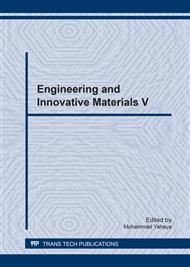p.90
p.99
p.104
p.108
p.113
p.119
p.127
p.133
p.138
Observation of Material Flow in Friction Stir Forming for A5083 Aluminum Alloy Gear-Rack
Abstract:
This paper reports observation of material flow in friction-stir forming of aluminum alloy gear racks. Friction-stir forming was newly developed by Nishihara and is dedicated for material forming. In the process, a material plate is placed on the die and friction stirring is conducted on its back surface. The material deforms due to high pressure and heat caused by the friction-stir process and deforms precisely to the shape of the die. The process has mainly been studied for microforming and mechanical jointing; however it was successfully utilized for net-shape forming of A5083 aluminum alloy gear racks. The authors observed the appearance of products, change of mark-off lines on its surface, and deformation of its longitudinal cross section by photo-processing. In addition, we evaluated the distribution of hardness in transverse cross sections of a product tooth. As a result, it was observed that the material did not flow in the transverse direction of the cavity of the gear-rack die, though more material filled at the retreating side than at the advancing side. The material filled the tooth-cavity mostly before passage of the tool probe over the tooth.
Info:
Periodical:
Pages:
113-118
Citation:
Online since:
March 2017
Authors:
Keywords:
Price:
Сopyright:
© 2017 Trans Tech Publications Ltd. All Rights Reserved
Share:
Citation:


